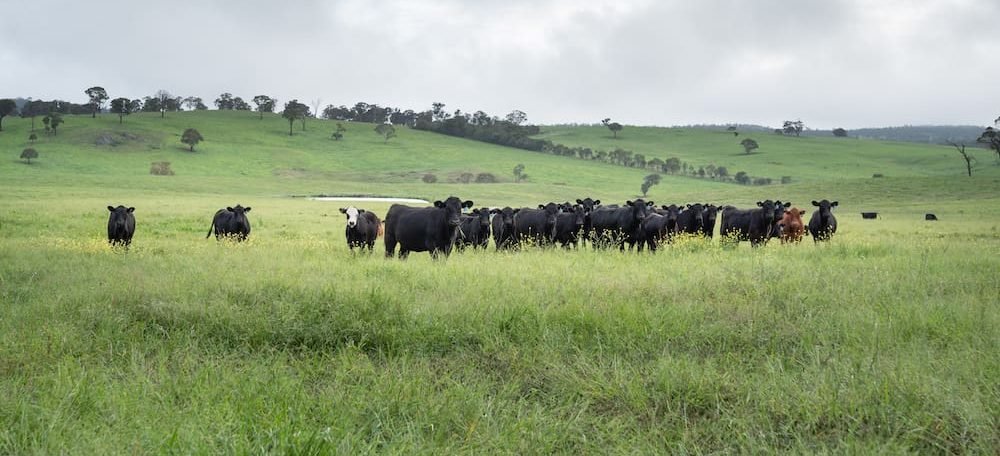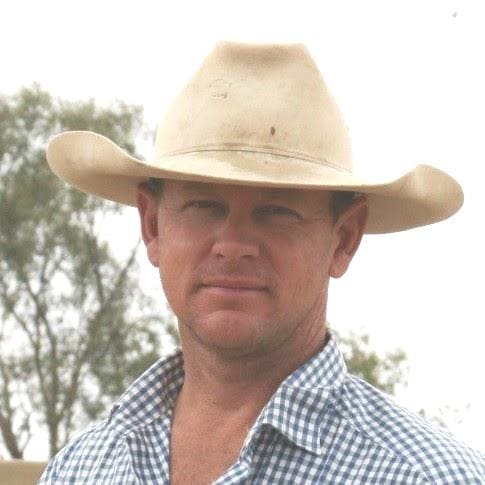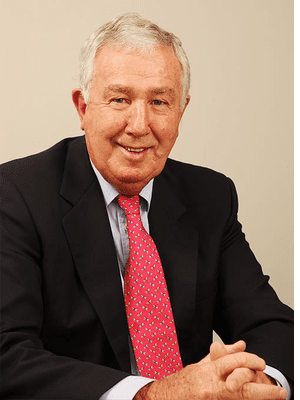
JUST as 2023 was ending not with a bang, but a whimper, widespread rain followed, pruder sentiments were lifted by trade and heavy lamb prices peaking in early January and a sharp New Year rally in young cattle prices.
It has changed the dynamics considerably for the rural property market, with any thoughts of another El Nino Summer now washed away.
In this week’s property review, industry specialists give their take on what lies ahead for the 2024 property year.
Rabobank
According to Rabobank’s newly released annual outlook, Australia’s agricultural sector is moving confidently into 2024 with an overall positive outlook for both producers and agribusiness industries.

Stefan Vogel
The agricultural banking specialist said a combination of better-than-expected seasonal conditions and lower input costs have helped set up the sector for a strong year.
“While commodity prices are well down on the highs experienced over the previous two years, price forecasts point to continued positive farm margins in key agricultural sectors in 2024.”
Report lead author, Stefan Vogel said the major agri sectors are moving into 2024 with a confident outlook after El Nino was not as bad as initially feared.
“Recent significant rainfall has been received across most farming areas except Western Australia. While the El Nino event continues into 2024, sea surface temperatures in the Pacific Ocean are declining and several key global weather agencies are predicting it to end in Q2.”
Darryl Langton, Nutrien Harcourts
Nutrien Harcourts property agent Darryl Langton said, “What a difference Christmas and the New Year have made.”
“While the season has been patchy, with some areas receiving storm rains, conditions are generally good across southern Queensland,” he said.

Darryl Langton
Mr Langton said the 2024 property market already had a number of positive indicators.
“Most producers have some green grass, the cattle market has responded, capital is readily available and the talk of interest rates domestically (and in the United States) is for rate cuts rather than rises.”
Mr Langton said despite a strong forecast, there was some caution.
“Unless producers find a neighbouring asset or a property enabling them to vertically integrate their business, they will proceed with a touch of caution compared to the past four to five years.”
As far as listings and campaigns go, he said the peak would likely be late summer into autumn.
“Some producers, keen to take their property to market last year, may have held back due to the seasonal conditions. They are keen to build their grass and water reserves before listing and as a result there is not a great volume of sellers at present.”
Mr Langton said demand remained strong.
“The vast majority of buyers are from local family farm units across the Maranoa and south-west Queensland, but there is always interest from corporate and institutional investors, as well as carbon and energy sectors.”
He said with a positive outlook for the cattle and grain markets, agriculture is a good place to invest.
Wally Cooper, Rural Property & Livestock
In Queensland’s central west, Rural Property & Livestock (RPL) principal Wally Cooper said 2024 property listings will be wet season dependant.
“There has been good rain in the Channel Country and significant flows in the Diamantina and Hamilton Rivers (the lower end of the Georgina), but the central west of Queensland has largely missed out,” Mr Cooper said.
“As far as presenting properties to market, it is a waiting game for those situated in areas that have missed out on a proper season,” he said.

Wally Cooper
Mr Cooper believes traction in the property market will start sometime around Easter.
“In terms of interest rates, some producers are adopting a ‘wait and see’ approach, but they are also season dependent – waiting to offer well-presented and well grassed properties to market.”
Mr Cooper said he has a buyer pool chasing quality assets.
“There is strong inquiry for tier one properties, however they are difficult to source because anyone with a good quality holding is reluctant to sell.”
“These properties always attract a premium and while there may be some consolidation in terms of tier two and three properties, prices will not head backwards because there is still plenty of positivity in the market,” he said.
Mr Cooper said while there was some interest in that natural capital space, his primary focus was producers (especially those he had dealt with historically), as well as domestic corporates.
Chris Meares, Meares and Associates
Meares and Associates principal Chris Meares is optimistic about the outlook for agriculture in 2024.
He said early indicators are showing significant upturns in many areas, with the beef cattle and trade lamb markets up nearly 50 percent.
“The Eastern Young Cattle Indicator which had reached an average high of 1064c/kg in late 2022 dropped to a record low of 349c/kg in October 2023. Today it stands at 635c/kg – nearly double the 2023 low.”

Chris Meares
Mr Meares said the same applies to the trade lamb industry.
In September 2023, the Trade Lamb index dropped to 411c/kg from 808c/kg in February, but by mid-January, it had recovered to 775c/kg.
Mr Meares attributes the returning optimistic levels to a number of factors including abnormally good summer rains.
“The February 2024 inflation figures have come in at a low level indicating there will be little appetite for increasing interest rates any further in the short term.”
And he said returns from rural investments remain attractive in comparison with equity investments or short-term money markets.
On the whole, he said many potential vendors held off selling during 2023 due to the dramatic drop in commodity prices together with other short-term uncertainties.
“This was further exacerbated by the expressions of interest process which failed to offer potential bidders any guidance about where to pitch their bids.”
Mr Meares said returning confidence levels are already helping to underpin investment certainty and reliability.
“This, together with the attractiveness and commercial viability of rural investment, will help to underpin the 2024 market.”
Mr Meares believes a two-speed market may continue into 2024.
“The top end market will remain positive and well sought after, however there will be some hesitancy remaining for investment in the more remote rural areas.”
He said in recent years, there has been a migration from the pastoral or lower rainfall to the higher rainfall areas, in particular along the east coast and hinterland.
“This trend will continue with much focus on quality and well-located properties.”
JLL Agribusiness

Bhavin Patel JLL
JLL Agribusiness director Bhavin Patel said given the lengthening in transaction time, corporates will this year have the ability to take time, conduct due diligence and make an offer.
“Previously, corporates had little time to act as the privates were highly active and required less time to commit to a purchase,” he said.
JLL director Clayton Smith expressed concern at the impact of Queensland’s land tax additional surcharge on foreign landholders.
“Other states do not apply this surcharge which I believe is holding back investment from some of the larger super funds,” he said.
“With large re-valuations giving uplift on statutory UCVs (unimproved capital value), the tax has become prohibitive. There is an uneven investment field, forcing the larger investors to turn south or stop at the border,” he said.
Mark Barber, Elders
As long as the supply of farmland remains low, Elders’ Mark Barber expects property prices to remain strong in 2024.
“There are no indications to suggest there will be a significant increase in the number of properties coming onto the market this year,” he said.
“All indications suggest livestock prices will continue to improve this year as the domestic oversupply slows down, the US switches to herd rebuilding and re-stockers become more active following recent widespread rain on the east coast and in the north.”

Mark Barber
Mr Barber said the mood of producers had improved.
“Better livestock prices and seasonal conditions have lifted the confidence of producers. The winter crop outlook has also improved with a potential emergence of La Nina conditions.”
Mr Barber said family farm balance sheets were in generally good shape and institutional investment in the sector did not show any sign of slowing down.
“There are numbers of large-scale fund managers actively raising capital with strong interest from offshore investors.”
Mr Barber believes the agricultural sector is looking for more evidence of an interest rate easing cycle.
However, he said an easing of rates would put upward pressure on land values in the spring.
“All of this means financial liquidity will remain high leading to continued strong demand for rural land. Added to this is the rapidly emerging demand for rural land from alternative land use.”
“Carbon farming, biodiversity and alternative energy schemes are land intensive. As we get closer to 2030 and emissions reduction targets get closer, demand for carbon projects will increase,” Mr Barber said.
Sam Triggs, Inglis Rural Property
Inglis Rural Property chief executive offer Sam Triggs is confident the buying pattern seen in 2023 will continue in 2024, with the market buoyed by those with strong equity positions.
“Key drivers of property prices are underlying commodity prices and the cost of debt/interest rates, but importantly buyer confidence/sentiment.”
Mr Triggs said the general market was shocked with the rapid increase of interest following mixed signals from the Reserve Bank and then a sharp correction in livestock prices due to incorrect forecasts from the Bureau of Meteorology.
“This double-whammy effect influenced buyers to take conservative positions and consolidate existing debt in Q3 and Q4, and as you would expect, widely publicised seasonal forecasts of El Nino impacted farmers confidence.”

Sam Triggs
Mr Triggs anticipates a more stable investment environment this year.
“An uplift in livestock markets is likely to continue off the back of the recent rainfall and a possible weaking El Nino outlook, in addition to processors increasing output and more liquid supply chains and export markets.”
Once again, good quality assets would attract interest and secondary type assets would be scrutinised.
“Capital is coming from a multitude of sophisticated Australian and international investors, with alternative investment objectives including carbon credits, natural capital, renewable energy, agri-forestry, biodiversity and traditional farming systems.”
Mr Triggs highlighted a further two trends that will be noticeable in 2024.
Larger scale investment will increasingly engage in joint ventures by pairing capital with skilled, incentivised existing farmers, he predicts.
“In addition, greater emphasis of providence and sustainability in production will become important in the marketplace.”
Mr Triggs has noticed a backlog of listings due to retiring family farmers.
“When land values were rising on the back of excellent seasons and historically high commodity prices, these producers chose not to sell. With growth now slowing down, the natural attrition of these exiting landowners (particularly in the $5m to $15m price bracket) should return to the market this year.”
Mr Triggs said a number of other dynamics will be at play in 2024.
“As carbon and biodiversity markets continue to mature and expand with examples of new Renewable Energy Zoning (REZ), there will be a continued push from corporations to buy or lease country required for the expanding needs of the energy and offsets markets.”
“We are seeing a good level of enquiry, however buyers are seeking value and looking for a return on investment,” Mr Triggs said.
